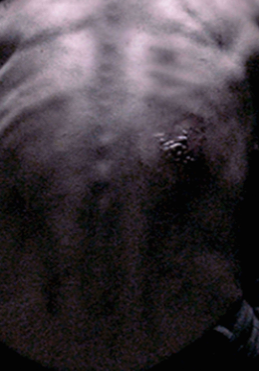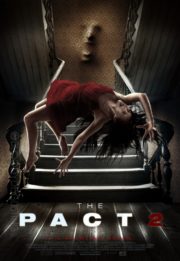A Descent into Darkness: The Suffering (2015)
“The pain never really goes away; you just learn how to live with it.” This haunting line echoes throughout The Suffering, a film that existentially tests the boundaries of fear, pain, and the human psyche. Released in 2015 and directed by the talented John R. Leonetti, The Suffering is a psychological horror film that intricately weaves together elements of supernatural terror and personal anguish. The story revolves around a group of friends who stumble upon a haunted monastery, awakening horrifying memories tied to a tragic past. As they delve deeper, their darkest fears come to life, leaving the question: what horrors lie beneath the surface of grief?
Crafting a Chilling Atmosphere
The Suffering excels in creating a horror atmosphere that immerses viewers in anxiety and dread. Leonetti employs a combination of suspense and a pervasive sense of foreboding, gradually revealing the dark secrets lurking within the monastery’s walls. This slow-burn approach is effective; the tension builds as the characters encounter unsettling occurrences that suggest malevolent forces at play. The film often employs shadowy corners and dimly lit hallways, planting a seed of uncertainty and danger in each scene, making viewers restless long before any shocking visuals appear.
The effective use of space amplifies the horror, as the sprawling, decaying monastery becomes a character in itself. Through meticulous framing and angles, Leonetti captures the claustrophobia of these old walls, symbolizing the characters’ entrapment in their psychological turmoil. The viewer constantly feels that danger is lurking just around the corner, a perception that intensifies the overall impact of the film. This gradual build-up allows the arc of horror to escalate naturally, leading to moments that catch the audience off guard while still feeling earned.
The Art of Visual Horror
Cinematography plays a pivotal role in achieving the film’s chilling atmosphere. The dim, earthy color palette contributes to the oppressive mood of the narrative, echoing themes of decay and despair. Shadows and light dance ominously, creating a palpable tension that mirrors the characters’ escalating fears. The camera angles often adopt a voyeuristic quality, as if we, too, are peering into something we should not witness. This technique pulls the viewer into the storyline, fostering a sense of helplessness that is fundamental to horror.
Special effects are strategically used and, while not overly reliant on gore, they effectively punctuate the unsettling nature of the film. The haunting imagery that emerges from the protagonists’ tormented memories and their encounters with supernatural entities leaves a lasting impression. Leonetti’s choice to feature practical effects in moments of terror enhances the realism and draws the audience deeper into the unfolding nightmare. His visual storytelling stands out, proving that horror can be both subtle and shocking.
The Power of Sound
Sound design in The Suffering is as key to its horror elements as visuals. The chilling soundtrack builds psychological tension, with unsettling whispers and ethereal melodies that amplify the eerie atmosphere. The film cleverly utilizes silence, allowing moments of stillness to hang heavy in the air, heightening the audience’s anticipation of what might come next. In scenes where sound suddenly cuts out, dread fills the void, making turns of the plot all the more jarring.
Specific instances, like the creaking of the monastery’s old floorboards or distant echoes, serve to remind us that the past (and present fears) is ever-present. The layers of sound, from faint whispers to sudden reverberations, envelop the audience, creating an immersive experience where every sound could signify impending doom. This attention to auditory detail adds further depth to the overall experience, making it integral to the film’s effectiveness as a horror narrative.
Performance Under Pressure
The performances in The Suffering add considerable weight to its horror. The actors embody their roles with a mix of authenticity and depth, enhancing the film’s sinister undertones. The characters’ complexities and struggles with their past traumas provide an emotional anchor that makes their reactions to terror believable and relatable. This connection elevates the horror experience from mere jump scares to an exploration of human fragility.
As fear crescendos, the actors portray a range of emotions that resonate, displaying genuine panic, despair, and even moments of camaraderie. This depth keeps viewers emotionally invested, understanding their motivations and fears as the chaos unfolds around them. Additionally, character backstories intertwine seamlessly with the storyline, making their ingestion of horror all the more poignant. The performances contribute to a strong narrative arc, allowing the horror elements to penetrate deeper into the audience’s psyche.
Exploring Horror’s Core
Delving into horror elements, The Suffering blends psychological and supernatural genres. The film delves into the aftermath of trauma, presenting horror not just as external scares but as an internal battle. The physical manifestations of grief and guilt experienced by the characters form the backbone of the story. This interplay between personal demons and external threats introduces an innovative take on horror, pushing boundaries within its subgenre.
The thematic foundation of the film, focusing on coping with loss and the pain of remembrance, taps into universal fears. The characters’ struggles resonate more as they confront their internal demons alongside tangible horrors. Such themes elevate the film beyond a standard horror flick, cultivating a powerful commentary on human resilience in the face of unbearable suffering. In this way, it challenges viewers to reflect on their own fears and the scars left by loss, broadening its emotional impact.
Effectiveness of Fright
The techniques employed to frighten viewers are varied and effectively executed. Relying on psychological fright rather than overt gore, the film builds an unsettling atmosphere that creates an impending sense of doom. Sudden revelations and shocking visual effects punctuate the narrative without overwhelming it. The deliberate pacing allows each scare to develop naturally, ensuring that the haunting moments linger long after leaving the theater.
The creators blend psychological terror with supernatural shocks, making the audience second-guess the nature of the threat. Does it stem from within or is it an external darkness? This ambiguity allows for thoughtful engagement rather than mere shock value. The Suffering evokes visceral reactions while engaging viewers’ minds, provoking thought as much as it instills fear.
Thematic Insights and Social Commentary
The Suffering offers poignant insight into the human condition, elevating it beyond simple horror entertainment. The film serves as a reflection on trauma, loss, and the struggle to cope with one’s past. It explores how unresolved grief can haunt individuals, manifesting both figuratively and literally. This introspection invites audiences to consider their approaches to trauma and healing, making the horror genre a vessel for deeper themes.
By intertwining personal narratives with the horror elements, the film emphasizes that the most terrifying demons often reside within. This nuanced portrayal of consciousness adds layers to the characters, making their journey not just one of fear, but of self-discovery, acceptance, and ultimately, resilience. These underlying themes resonate powerfully, giving The Suffering a substantial impact that lingers long after the credits roll.
Who Will Enjoy This Film?
The Suffering is tailored for horror aficionados who appreciate psychological complexity alongside supernatural terror. Viewers looking for a film that evokes introspection and emotion alongside its horror elements will find much to appreciate here. However, casual viewers may find the film more demanding, as it requires emotional investment and a willingness to confront unsettling themes.
Fans of psychological horror, intense character studies, and subtle tension will find The Suffering rewarding. Its layered narrative, rich atmospheric details, and complex performances create a viewing experience that lingers long after watching. For those who prefer straightforward scares or excessive gore, this film may feel slow or less thrilling, but it compensates with depth and sophistication.
Final Thoughts: A Complex Horror Experience
The Suffering stands as a well-crafted horror narrative that deftly blends psychological depth with supernatural elements. The strengths lie in its atmospheric construction, thoughtful character development, and immersive soundtrack. While some may find its pacing slow, it instead cultivates tension and provokes emotional engagement.
As a horror film, it is genuinely frightening, thought-provoking, and innovative, challenging conventional horror norms to grapple with its characters’ inner struggles. Its underlying themes of trauma and loss add significant depth, elevating the film beyond mere shock value.
In summary, The Suffering is highly recommended for those seeking a horror film that stimulates both fear and contemplation. Viewers looking for light scares or conventional horror tropes might want to adjust their expectations beforehand. As for graphic content, the film contains some intense sequences that depict trauma and grief, possibly triggering for sensitive viewers, so discretion is advised. Overall, The Suffering delivers an unsettling yet impactful experience that resonates deeply.




